
Research Article
Ann Hematol Onco. 2024; 11(1): 1444.
Detection of Prethrombotic State Malignant Neoplasms, Including Pancreatic Cancer, Using Clot Waveform Analysis
Mayu Kobayashi1; Hideo Wada2; Shunsuke Fukui1; Yasuaki Shimada1; Yuuichi Nakazawa1; Hiroki Mizutani1; Yuhuko Ichikawa3; Yuuki Nishiura1; Isao Moritani1; Yutaka Yamanaka1; Hidekazu Inoue1; Motomu Shimaoka4; Hideto Shimpo5; Katsuya Shiraki1,2
1Department of Gastroenterology, Mie Prefectural General Medical Center, Yokkaichi 510-8561, Japan
2Department of General and Laboratory Medicine, Mie Prefectural General Medical Center, Yokkaichi 510-8561, Japan
3Department of Central Laboratory Medicine, Mie Prefectural General Medical Center, Yokkaichi 510-8561, Japan.
4Department of Molecular Pathobiology and Cell Adhesion Biology, Mie University Graduate School of Medicine, Tsu 514-8507, Japan
5Mie Prefectural General Medical Center, Yokkaichi 510-8561, Japan
*Corresponding author: Katsuya Shiraki, MD, PhD Department of Gastroenterology, Mie Prefectural General Medical Center, 5450-132 Hinaga, Yokkaichi, Mie 510-8561, Japan.
Hideo Wada, MD, PhD Department of General and Laboratory Medicine, Mie Prefectural General Medical Center, 5450-132 Hinaga,Yokkaichi, Mie 510-8561, Japan. Tel: +81-59-345-2321; Fax: +81-9-347-3500 Email: katsuya-shiraki@mie-gmc.jp; wadahide@clin.medic.mie-u.ac.jp
Received: December 06, 2023 Accepted: January 06, 2024 Published: January 13, 2024
Abstract
Background: Cancer, especially pancreatic cancer, is frequently associated with thrombosis which is one of the causes of poor outcomes; moreover hypercoagulability can be present in cancer patients. Hypercoagulability is considered to be caused by a thrombin burst.
Methods: Activated Partial Tthromboplastin Time (APTT), small amount of tissue factor induced FIX activation assay (sTF/FIXa) and Thrombin Time (TT) assessment using Clot Waveform Analysis (CWA) were performed in 138 patients with malignant neoplasms, including pancreatic cancer.
Results: The first derivative peak (1st DP) time (1st DPT), 1st DP height (1st DPH) and 1st DPH/1st DPT ratio were increased in a clotting-factor-FVIII-dependent manner. Thrombosis was frequently associated with pancreatic cancer and was observed in the early stage. CWA-APTT and CWA-sTF/FIXa indicated that the peak times and heights were markedly longer and higher, respectively, in cancer patients, especially pancreas cancer patients, than in patients without cancer. The 1st DPH/1st DPT ratios of CWA-sTF/FIXa were significantly high in patients with pancreas cancer (median value 1.5). CWA-TT showed that the peak times were significantly shorter in cancer patients than in healthy volunteers and that the peak heights were significantly higher in cancer than in benign pancreas diseases. The cutoff value of the 1st DPH/ 1st DPT of sTF/FIXa for cancer patients with thrombosis vs. all patients without cancer was 1.3.
Conclusions: Cancer patients, including those with pancreatic cancer were frequently associated with thrombosis due to hypercoagulability caused by thrombin burst detected by CWA. A high 1st DPH/1st DPT ratio of sTF/FIXa may suggest an association with cancer or thrombosis.
Keywords: Cancer; Pancreatic cancer; CWA; sTF/FIXa; 1st DPH/ 1st DPT; sTF/FIXa ratio
Introduction
Thrombotic complications such as Venous Thromboembolism (VTE), Acute Cerebral Infarction (ACI) and Acute Coronary Syndrome (ACS) have often been reported and studied as Cancer-Associated Thrombosis (CAT) by many physicians and researchers [1-3]. The incidence of VTE is <0.1% in the general population; it has been reported that approximately 20% of the overall VTE incidence might be caused by active cancer [4]. CAT, including ACS, ACI and VTE, is considered a main cause of noncancer death in patients with cancer [5]. VTE is one of the most important thrombotic complications in patients with cancer [6,7], and ACS and ACI are arterial thromboses that are mainly caused by platelet activation and atherosclerosis [8,9]. Trousseau syndrome [10,11] is a well-known thrombotic syndrome in cancer patients. CAT, including Trousseau syndrome is associated with various thrombotic diseases and has various factors, including leukocytosis, thrombocytosis, physical factors and increased coagulation factors, which have been proposed as risk factors for CAT [1].
Hypercoagulability including increased levels of coagulation factors, such as Tissue Factor (TF) and clotting factor VIII (FVIII), activated coagulation factors and TF-positive microparticles was proposed as a risk factor for CAT [1]. Activation of the coagulation cascade and platelets which is related to tumor growth and metastasis, may cause CAT [12,13]. Therefore, early diagnosis of hypercoagulability and prophylaxis for CAT may be important in the management of cancer [10].
Although increased D-dimer or Soluble Fibrin (SF) levels are useful for detecting thrombosis in patients with CAT [14-16], routine coagulation tests, such as Activation Partial Thromboplastin Time (APTT) and Prothrombin Time (PT), cannot detect hypercoagulable states [17]. A Clot Waveform Analysis (CWA) of APTT (CWA-APTT) has been developed to evaluate hemostatic abnormalities in patients with bleeding tendencies and to monitor anticoagulant therapy [17-19]. Furthermore, the use of a small scale of TF-induced FIX activation (sTF/FIXa) (CWA-sTF/FIXa) assay can evaluate hemostatic abnormalities including platelet abnormalities [17]. Hypercoagulability is considered to be caused by a thrombin burst [20,21] which is evaluated by thrombin time using a small amount of thrombin with a CWA (CWA-TT) [22].
In the present study, hypercoagulability and complications of thrombosis in patients with malignant neoplasms including pancreatic cancer were investigated using a CWA-APTT, CWA-sTF/FIXa and CWA-TT in comparison to patients without cancer or those with benign pancreatic diseases.
Materials and Methods
The study population included 138 patients with cancer and 66 patients without cancer who were managed at Mie Prefectural General Medical Center from August 21, 2020 to December 31, 2022. Cancer types were pancreatic cancer (n=30), uterine cancer (n=4), prostate cancer (n=7), hepatocellular carcinoma (n=15), malignant lymphoma (n=9), leukemia and myelodysplastic syndrome (leukemia/MDS) (n=11), lung cancer (n=11), breast cancer (n=5), biliary tract cancer (n=11), colon cancer (n=10), stomach cancer (n=12), esophageal cancer (n=5) and other cancer (n=8; origin unknown, n=3; bladder cancer, n=2; kidney cancer, n=2 and ovarian cancer, n=1) (Table 1). Noncancer patients included those with chronic hepatitis (n=31), anemia (n=9), bone marrow proliferative disease (n=6), pregnancy loss (n=3), fatty liver (n=3), carrier of hepatitis B virus (n=4), alcoholic liver damage (n=2), hepatic hemangioma (n=2), pancreatic cyst (n=3), benign pancreatic tumor (n=2) and pancreatitis (n=1). CWA was also performed in 20 healthy volunteers as controls. Disseminated intravascular coagulation (DIC) was diagnosed using the Japanese Ministry of Health Labor and Welfare criteria for DIC [23]. Acute cerebral infarction was diagnosed using computed tomography or magnetic resonance imaging, acute coronary syndrome was diagnosed using coronary angiography, electrocardiography was based on elevated troponin levels, and venous thromboembolism was diagnosed using computed tomography or venous ultrasound [24]. The stage of pancreatic cancer was determined in accordance with the established guidelines [25,26].
N
Age (years)
Sex (F:M)
Thrombosis
Pancreatic cancer
30
70.3±10.7
12:18
11/30(36.7%)
Uterine cancer
4
60.5±9.7
4:0
1/4(25.0%)
Prostate cancer
7
76.9±6.3
0:7
3/7(43.0%)
Hepatocellular carcinoma
15
72.3±8.1
0:15
3/15(20.0%)
Malignant lymphoma
9
68.2±19.1
6:3
4/9(44.4%)
Leukemia/myelodysplastic syndrome
11
74.3±14.1
4:7
1/11(6.7%)
Lung cancer
11
69.6±11.0
3:8
3/11(27.3%)
Breast cancer
5
69.8±11.9
5:0
0/5(0%)
Biliary tract cancer
11
78.7±6.2
6:5
1/11(9.1%)
Colon cancer
10
73.6±11.6
4:6
0/10(0%)
Gastric cancer
12
76.8±10.9
0:12
3/12(25.0%)
Esophageal cancer
5
66.8±9.5
0:5
1/5(20.0%)
Others
8
77.4±10.5
1:7
3/8(37.5%)
Total
138
72.4±11.4
45:93
34/138(24.6%)
Table 1: Subjects’ details.
The study protocol (2019-K9) was approved by the Human Ethics Review Committee of Mie Prefectural General Medical Center, and informed consent was obtained from each participant. This study was carried out in accordance with the principles of the Declaration of Helsinki.
The CWA-APTT was performed using APTT-SP®, which uses silica as an activator of FXII and synthetic phospholipids (Werfen; Bedford, MA, USA) and platelet-poor plasma (PPP), with an ACL-TOP® system (Werfen) as previously reported [17,27]. The CWA- sTF/FIXa assay was performed using Platelet-Rich Plasma (PRP) and 2000-fold diluted HemosIL RecombiPlasTin 2G (TF concentration <0.1 pg/ml; Werfen) [28]. One curve and two Derivative Peaks (DPs) are shown on the monitor of this system [17]; one shows the changes in the absorbance observed while measuring the APTT, corresponding to the Fibrin Formation Curve (FFC); the second (first derivative peak 1st DP) corresponds to the coagulation velocity; and the third (second derivative peak 2nd DP) corresponds to the coagulation acceleration. The respective height and time of the 1st DP, 2nd DP, and fibrin formation are called the 1st DP height (1st DPH) and 1st DP time (1st DPT), 2nd DPH and 2nd DPT, and Fibrin Formation Height (FFH) and fibrin formation time (FFT), respectively (Figure 1). PRP was prepared by centrifugation at 900 rpm for 15 minutes (platelet count, 40 x 1010 /L), and PPP was prepared by centrifugation at 3000 rpm for 15 minutes (platelet count, <0.5 x 1010 /L) [29].
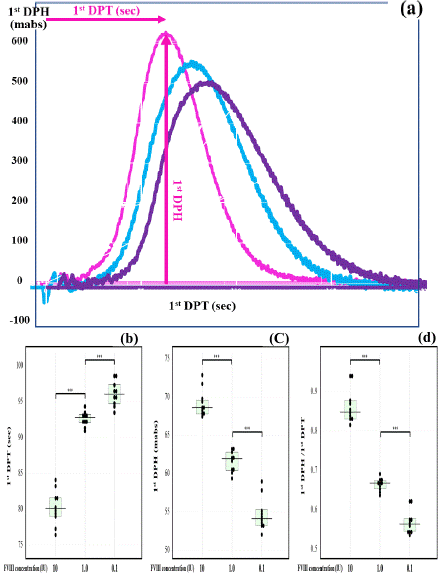
Figure 1: First derivative (a), 1st DPT (b), 1st DPH (c) or 1st DPH/DPT ratio (d) of CWA-sTF/FIXa in FVIII 10 IU, 1IU or 0.1 IU. pink, FVIII 10 IU; blue, FVIII 1 IU; purple, FVIII 0.1 IU; 1st DPT, first derivative peak time; 1st DPH, first derivative peak height; ***, p<0.001.
The CWA-TT was measured using 0.5 IU thrombin (Thrombin 500 units Mochida Pharmaceutical CO., LTD, Tokyo, Japan) with an ACL-TOP® system (Instrumentation Laboratory) [17]. Three types of curves are shown on this system monitor [22]. The 1st DP showed two peaks and the second peak height of the 1ST DP (1st DPH-2) reflected the thrombin burst.
In total, 10 units, 1 unit and 0.1 unit of clotting factor VIII (FVIII) concentration in plasma were prepared through the dilution of recombinant FVIII concentrate (efraloctocog alfa, Sanofi in Japan, Tokyo, Japan) using FVIII-deficient plasma (Werfen) to examine the relationship between the peak time, peak height, or peak height/time ratio of the CWA and FVIII concentration.
Statistical Analyses
The data are expressed as the median (range). The significance of differences between groups was examined using the Mann-Whitney U test. The cutoff values, determined as the point at which the sensitivity curve and specificity curve intersected, were examined through Receiver Operating Characteristic (ROC) analysis. P values of <0.05 were considered to indicate a statistical significance. All statistical analyses were performed using the Stat-Flex software program (version 6; Artec Co., Ltd, Osaka, Japan).
Results
The frequency of thrombotic complications was high in cases of pancreatic cancer (36.7%), prostate cancer (43.0%), malignant lymphoma (44.4%), and others (37.5%) (Table 1). Thrombotic complications were seen in 18 patients with VTE (pancreatic cancer, 8, and other cancer, 10), 6 patients with acute cerebral infarction (pancreatic cancer, 1, and other cancer, 5), 4 patients with DIC (pancreatic cancer, 1, and other cancer, 3), 1 patient with acute coronary syndrome (pancreatic cancer), and 1 patient with thrombotic microangiopathy (other cancer). The frequency of thrombosis tended to be higher in patients with pancreatic cancer than in those with other cancers (19.4%), although this difference was not significant. The thrombotic complications in patients with other cancers gradually increased as the stage of cancer progressed; however, a high frequency of thrombotic complications (60%) was observed in stage I pancreatic cancer (Table 2).
Stage
n
Age (years)
Sex (F:M)
Thrombosis (n, %)
Pancreatic
cancerI
5
73.5±13.0
3:2
3$1, 60%
II
4
80.7±5.7
1:3
0, 0%
III
3
72.5±13.4
2:1
2$3, 66.7%
IV
18
67.4±11.1
6:12
6$4, 33.3%
Total
30
70.2±11.4
12:18
11, 36.7%
Other
cancersI
24
76.4±8.9
7:30
3#1, 12.5%
II
19
71.6±9.0
4:14
3#2, 15.8%
III
18
73.0±11.2
5:14
4#3, 22.2%
IV
37
69.5±11.1
10:14
9#4, 24.3%
Total
98
73.2±10.2
26:72
19, 19.4%
$1, two with VTE and one with acute coronary syndrome; $3, two with VTE; $4, four with VTE, one with DIC and one with ACI; #1, two with VTE and one with ACI; #2, two with VTE and one with ACI; #3, two with VTE, one with DIC and one with ACI; #4, four with VTE, two with ACI, two with DIC and one with thrombotic microangiopathy; VTE, venous thromboembolism; DIC, disseminated intravascular coagulation; ACI, acute cerebral infarction.
Table 2: Stage and thrombosis in patients with pancreatic cancer and other cancers.
Figure 1 showed the 1st DP of CWA-sTF/FIXa in 10 IU, 1 IU, or 0.1 IU of the FVIII concentration in plasma. Peak times, peak heights or peak height/time ratios of 1st DP in CWA-sTF/FIXa FVIII-dependently prolonged or decreased from 10 IU to 0.1 IU of FVIII concentrate. Figure 2 shows the results of the CWA-APTT in a patient with pancreatic cancer (a), esophageal cancer (b), chronic hepatitis (c), and pancreas cyst (d). The peak heights of the FFC, 1st DP and 2nd DP were highest in the patient with pancreatic cancer, followed by the patient with esophageal cancer.
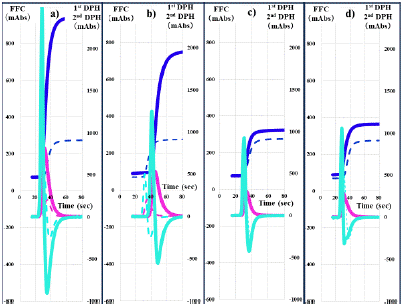
Figure 2: CWA-APTT in patients with pancreatic cancer a), esophageal cancer b), chronic hepatitis c) or pancreatic cysts d). FFC (navy line), fibrin formation curve; 1st DPH (pink line), first derivative peak height; 2nd DPH (light blue line), second derivative peak height.
Figure 3 depicts the results of statistical analysis for the CWA-APTT in patients with cancer, cancer patients with and without pancreatic cancer, patients with benign pancreatic diseases, patients without cancer and healthy volunteers. The peak times of the CWA-APTT in patients with cancer were significantly longer than those in patients without cancer and healthy volunteers. The peak times of the CWA-APTT were significantly longer in patients with pancreatic cancer than patients with benign pancreatic diseases (median, 2nd DPT 34.8 sec vs. 29.1 sec, p<0.05; 1st DPT 38.4 sec vs. 31.5 sec, p<0.05; FFC 38.9 sec vs. 33.7 sec, p<0.05). There were no significant differences in the peak times between patients with pancreatic cancer and those with other cancers and between patients without cancer and healthy volunteers.
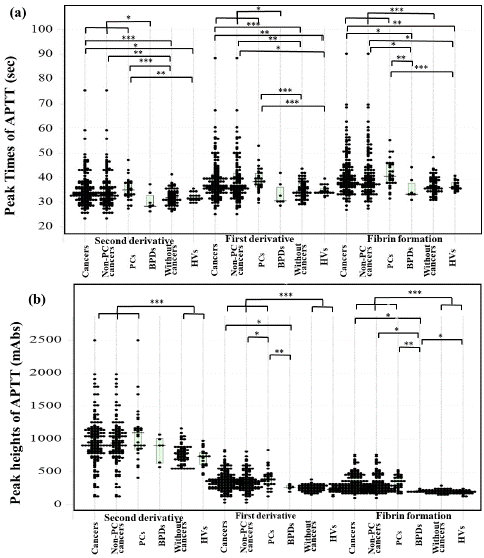
Figure 3: The peak times (a) and peak heights (b) of CWA-APTT in patients with cancer, with non-PC cancer, PC, BPD, and patients without cancers and HVs. PC, pancreas cancer; BPD, benign pancreatic disease; HVs, healthy volunteers; CWA, clot wave form; APTT, activated partial thromboplastin time; ***, p<0.001; **, p<0.01; *, p<0.05.
The peak heights in patients with cancer (median, 2nd DPH 953 mm absorbance; 1st DPH 345 mm absorbance; FFC 285 mm absorbance) were also significantly higher than those in patients without cancer (median, 2nd DPH 761 mm absorbance, p<0.001; 1st DPH 255 mm absorbance, p<0.001; FFC 201 mm absorbance, p<0.001) and healthy volunteers (median, 2nd DPH 734 mm absorbance, p<0.001; 1st DPH 235 mm absorbance, p<0.001; FFC 187 mm absorbance, p<0.001). There were no significant differences in the peak heights of the CWA-APTT between patients without cancer and healthy volunteers. The 1st DPH of CWA-APTT was significantly higher in patients with pancreatic cancer (median, 353 mm absorbance) than in patients with other cancers (median, 331 mm absorbance, p<0.05) and patients with benign pancreatic diseases (median, 325 mm absorbance, p<0.01). The FFC was significantly higher in patients with pancreatic cancer (median, 355 mm absorbance) than in patients with benign pancreatic diseases (median, 211 mm absorbance, p<0.01).
Regarding CWA-sTF/FIXa in PRP (Figure 4), the peak times of CWA-sTF/FIXa were shorter in patients without cancer than in patients with cancers and healthy volunteers. The peak heights of FFC, 1st DP and 2nd DP were highest in patient with pancreatic cancer followed by patient with esophageal cancer. In the statistical analysis (Figure 5), the peak times of the CWA-sTF/FIXa were shorter in patients without cancer (median, 2nd DPT 70.2 sec; 1st DPT 85.0 sec; FFC 86.2 sec) than in patients with cancer (median, 2nd DPT 78.3 sec, p<0.001; 1st DPT 95.9 sec, p<0.001 and FFC 97.2 sec, p <0.001) and healthy volunteers (median, 2nd DPT 76.9 sec, p<0.01; 1st DPT 95.3 sec, p<0.001 and FFC 94.6 sec, p <0.01). The 2nd DPT values of patients with pancreatic cancer (median, 78.1 sec, p<0.05) and with other cancers (median, 78.3 sec, p<0.05) were significantly longer than those of patients with benign pancreatic diseases (median, 59.7 sec).
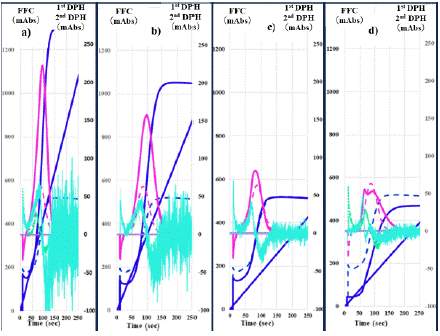
Figure 4: CWA-sTF/FIXa in patients with pancreatic cancer a), esophageal cancer b), chronic hepatitis c) or pancreatic cysts d). FFC (navy line), fibrin formation curve; 1st DPH (pink line), first derivative peak height; 2nd DPH (light blue line), second derivative peak height; CWA, clot waveform analysis; sTF/FIXa, small-scale of tissue-factor-induced FIX activation; navy line, fibrin formation curve; 1st derivative curve (velocity); light blue, 2nd derivative curve (acceleration); solid line, patient; dotted line, healthy volunteer.
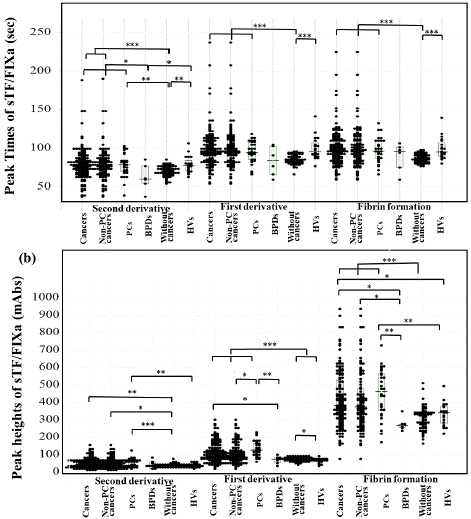
Figure 5: The peak times (a) and peak heights (b) of CWA-sTF/FIXa in patients with cancer, patients with non-PC cancer, PC, BPD, and patients without cancers and HVs. PC, pancreas cancer; BPD, benign pancreatic disease; HVs, healthy volunteers; CWA, clot wave form; sTF/FIXa, small-scale tissue-factor-induced FIX activation; 1stDPT, first derivative peak time; 1stDPH, first derivative peak height; ***, p<0.001; **, p<0.01; *, p<0.05.
There were no significant differences in peak times among patients with pancreatic cancer, other cancers and benign pancreatic diseases. The 2nd DPH (median, 47.1 mm absorbance vs. 36.9 mm absorbance, p<0.01), 1st DPH (median 95.9 mm absorbance vs. 85.0 mm absorbance, p<0.001) and FFH (median, 384 mm absorbance vs. 324 mm absorbance, p<0.001) were significantly higher in patients with cancer than in those without cancer. The 1st DPH was significantly higher in patients with pancreatic cancer (median, 127 mm absorbance) than in patients with other cancers (median, 96.1 mm absorbance, p<0.05) and patients with benign pancreatic diseases (median, 74.7 mm absorbance, p<0.01). The FFH (median, 463 mm absorbance vs. 268 mm absorbance, p<0.01) was significantly higher in patients with pancreatic cancer than in patients with benign pancreatic diseases. There were no significant differences in the 2nd DPH or FFH between patients with pancreatic cancer and patients with other cancers. The 1st DPH/1st DPT ratios of CWA-sTF/FIXa in patients with PC (1.4: 1.1-1.7) were significantly higher than those in patients with cancer (1.1: 0.7-1.6), non-PC cancer (1.1: 0.7-1.5) or BPD (0.8: 0.6-1.1) and in patients without cancer (0.9: 0.8-1.0) and in healthy volunteers (0.7: 0.6-0.8) - these were significantly higher in cancer patients than in patients without cancer (Figure 6).
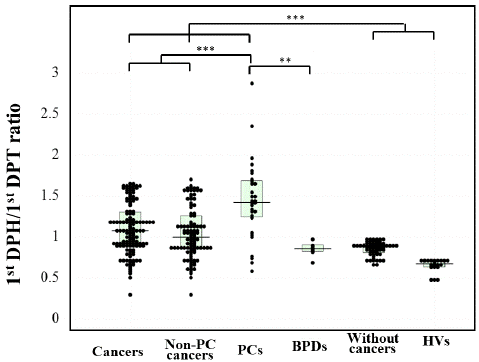
Figure 6: The 1st DPH/1st DPT ratio of CWA-sTF/FIXa in patients with cancer, patients with non-PC cancer, PC, BPD, and patients without cancers and HVs. PC, pancreas cancer; BPD, benign pancreatic disease; HVs, healthy volunteers; CWA, clot wave form; sTF/FIXa, small-scale tissue-factor-induced FIX activation; 1stDPT, first derivative peak time; 1stDPH, first derivative peak height; ***, p<0.001; **, p<0.01.
Regarding CWA-TT, the peak heights were significantly higher in PRP than in PPP. The second 1st DPH was extremely high in patients with pancreatic cancer (Figure 7). The 2nd DPT, 1st DPT-1, and FFC were significantly shorter in cancer patients and patients without cancers than in healthy volunteers. Only the 1st DPT-2 was significantly shorter in patients with cancer than in patients without cancer and healthy volunteers. The 2nd DPH, 1st DPH-1, 1st DPH-2, and FFH were significantly higher in patients with cancer than in healthy volunteers. The 2nd DPH, 1st DPH-2 and FFH were significantly higher in patients with cancer than in patients without cancer. The 2nd DPH and 1st DPH-1 were significantly lower in patients with benign pancreatic diseases than in patients with pancreatic cancer or other cancers (Figure 7).
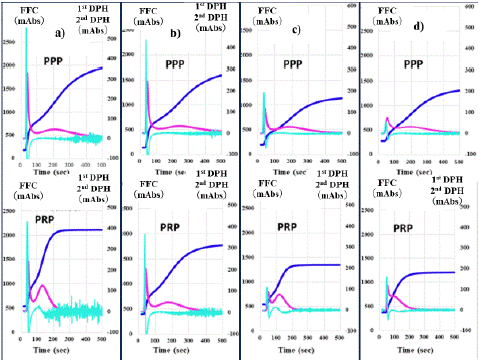
Figure 7: CWA-TT in patients with pancreatic cancer a), esophageal cancer b), chronic hepatitis c) or pancreatic cyst d). CWA, clot waveform; analysis TT, thrombin time; navy line, FFC, fibrin formation curve; pink line, 1st derivative curve (velocity); 1st DPH, first derivative peak height; light blue, 2nd derivative curve (acceleration); 2nd DPH, second derivative peak height; solid line, patient; dotted line, healthy volunteer.
Among CAT patients, cancer patients without thrombosis, all cancer patients, all patients without cancer and all patients without thrombosis, there were no significant differences in the 1st DPT on sTF/FIXa among CAT patients, cancer patients without thrombosis, all cancer patients, and all patients without thrombosis (Figure 8 (a). The 1st DPH on the CWA-sTF/FIXa was higher in CAT patients (136 mabs: 119-189 mabs) than in other groups (Figure 8 (b). The 1st DPH/DPT ratio in CAT patients (1.5: 1.2-2.0) was the highest among all groups (Figure 8 (c). Adequate cutoff values of the 1st DPH/ 1st DPT ratio on sTF/FIXa for all cancer patients vs. all patients without cancer, and patients with CAT vs. cancer patients without thrombosis, all patients without thrombosis and non-cancer patients without thrombosis were 0.9. 1.3, 1.3 and 1.0, respectively (Figure 9 and Table 3).
AUC
Cutoff value
Sensitivity
(specificity)Odds ratio
All patients with cancer vs. all patients without cancer
0.674
0.9
63.8%
1.6
Patients with CAT vs. cancer patients without thrombosis
0.702
1.3
61.4%
2.5
Patients with CAT vs. all patients without thrombosis
0.786
1.3
72.2%
6.7
Patients with CAT vs. non-cancer patients without thrombosis
0.915
1.0
84.5%
36.7
Patients treated with anticoagulants were excluded from this analysis; AUC, area under the curve; CAT, cancer-associated thrombosis.
Table 3: Receiver operating characteristic analysis of the first derivative peak height/time ratio of small-scale tissue- factor-induced FIX activation assay for the diagnosis of cancer or thrombosis.
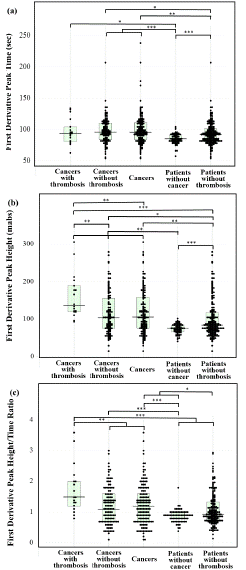
Figure 8: First derivative peak time (a), peak height (b) and peak height/ time ratio of the small scale-tissue- factor-induced FIX activation assay in cancer patients, those with and without thrombosis, those without cancer and those without thrombosis. *, p<0.05; **, p<0.01; ***, p<0.001.
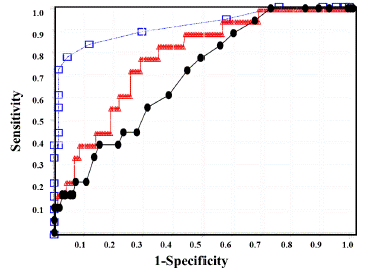
Figure 9: Receiver operating characteristic analysis of the first derivative peak height/time ratio on the small- scale tissue-factor-induced FIXa activation assay for cancer patients with thrombosis vs. cancer patients without thrombosis (black circle), all patients without thrombosis (red triangle) or non-cancer patients without thrombosis (blue square).
Discussion
CAT is a condition whose relevance has been recognized frequently both among physicians who deal with VTE and oncologists [30]. The annual incidence of VTE is 0.5% in cancer patients compared with <0.1% in the general population, active cancer accounts for 20% of the overall incidence of VTE [30]. Several mechanisms underlying the prothrombotic state in these patients have been proposed. Increased levels of clotting factors, leukocytes, platelets, and TF-positive microparticles are all potential factors that increase CAT either alone or in combination [31]. After activation of the coagulation system, fibrin- related markers, such as D-dimer, SF and FDP are increased; these biomarkers are used for the diagnosis and exclusion of VTE [32, 33]. The platelet activation receptor C-type lectin-like receptor 2 (CLEC-2) and its endogenous ligand podoplanin have attracted the attention of many researchers [34].
In this study, 24.6% of patients with thrombotic diseases had malignant neoplasms, indicating that these cancer patients were in a hypercoagulable state. In particular, 36.7% of pancreatic cancer patients were associated with thrombosis, suggesting that pancreatic cancer patients are markedly hypercoagulable and have a high risk of thrombosis. Patients with pancreatic cancer have a very high risk of both venous and arterial thrombosis compared with those with other cancers, caused by their tumor-driven hypercoagulable state [35]. The present study also demonstrated the significant prolongation of peak times of CWA-APTT which is equal to routine APTT in cancer patients including those with pancreatic cancer. Although these findings may prompt misunderstanding that hypocoagulability exists in cancer patients, the markedly increased peak heights of the CWA-APTT and CWA- sTF/FIXa actually suggest a hypercoagulable state in patients with cancer including those with pancreatic cancer. The APTT using massive phospholipids and substances that activate the contact system does not reflect physiological coagulation, whereas the sTF/FIXa using PRP instead of massive phospholipids does reflect physiological coagulation.
The mechanism underlying hypercoagulability in pancreatic cancer [36-38] involves increased procoagulant factors, including fibrinogen [39], FVIII [40], TF [41,42] and reduced anticoagulant factors [37,43]. Fibrinogen is measured via clotting assays; therefore, the fibrinogen activity may be higher than fibrinogen antigen in the hypercoagulable state. Markedly high peak heights of the sTF/FIXa using small amount of TF suggest that intrinsic TF released from cancer cells exists in plasma. Thrombin causes an elevation in FVIII activity and increases the activation cycle from thrombin to FXIa, called the thrombin burst [22]. Elevated peak heights, especially the second peak of the 1st DPH (1st DPH-2) of CWA-TT suggest that the thrombin burst worsens hypercoagulability in cancer patients including those with pancreatic cancer. Platelet aggregation induced by tumor cells is a key contributor to the prothrombotic state in pancreatic cancer. Pancreatic cancer cell lines induce platelet aggregation in vitro via a thrombin-dependent mechanism [44]. In the present study, the CWA-sTF/FIXa assay in PRP showed hypercoagulability and the CWA-TT showed that the peak heights were significantly higher in PRP than in PPP, suggesting that platelets may play an important role in hypercoagulability in cancer patients. Human pancreatic tumors and cell lines have been shown to express Plasminogen Activator Inhibitor type 1 (PAI-1), a key inhibitor of fibrinolysis [45], suggesting that the evaluation of fibrinolysis is important. However, CAT with hyperfibrinolysis may cause DIC in patients with advanced stomach cancer [46], whereas DIC is rare in patients with pancreatic cancer. TF borne by circulating microparticles released from TF-expressing pancreatic cancer cells might contribute to thrombosis formation [47]. Elevated cytokines [48] and neutrophil extracellular traps [49] may cause inflammatory thrombosis. These reports suggest that evaluations of white blood cells, including neutrophils and monocytes, might be important.
In clinical practice, elevated 1st DPH on sTF/FIXa demonstrates hypercoagulability, suggesting an association with cancer or thrombosis. In the present study, adequate cutoff values of the 1st DPH on sTF/FIXa for cancer or CAT were 81.0 mm absorbance and 118 mm absorbance, respectively. The cutoff value of the 1st DPH on sTF/FIXa for acute cerebral infarction was previously reported to be 83.8 mm absorbance [50]. These findings suggest that patients with CAT may be more hypercoagulable than patients without cancer. However, this value was not sufficient to perform clinical practice. The 1st DPT was FVIII-dependently shortened and the 1st DPH was FVIII-dependently increased, suggesting that the clotting ability depended on both peak time and peak height. As the 1st DPT was pronged in cancer patients, the 1st DPH/1st DPT ratio instead of only 1st DPH might be useful for detecting hypercoagulability. These findings suggest that patients with pancreas cancer who exhibit 1st DPH/1st DPT ratio values may have hypercoagulability and are at risk of thrombosis.
In Conclusions, elevated peak heights of CWA-APTT, CWA-sTF/FIXa and CWA-TT indicated marked hypercoagulability induced by TF released from cancer cells, platelet activation and thrombin burst in patients with malignant neoplasms including pancreatic cancer. An elevated 1st DPH/1st DPT ratio on sTF/FIXa may suggest an association with cancer or thrombosis.
Author Statements
Funding
This research was funded by a Grant-in-Aid from the Ministry of Health, Labour and Welfare of Japan.
Acknowledgments
The authors thank Nisii H. and Sakano Y. for their excellent assistance in performing the CWA assay. The authors also thank the many technicians at Central Laboratory for measuring the laboratory data and the many physicians who took care of the patients.
Conflicts of Interest
The CWA measurements were partially supported by Werfen. For the rest of the study, the authors declare no conflicts of interest.
References
- Hisada Y, Mackman N. Cancer-associated pathways and biomarkers of venous thrombosis. Blood. 2017; 130: 1499-506.
- Mahajan A, Brunson A, White R, Wun T. The epidemiology of cancer-associated venous thromboembolism: an update. Semin Thromb Hemost. 2019; 45: 321-5.
- Cohen O, Caiano LM, Tufano A, Ageno W. Cancer-associated splanchnic vein thrombosis. Semin Thromb Hemost. 2021; 47: 931-41.
- Fernandes CJ, Morinaga LTK, Alves JL Jr, Castro MA, Calderaro D, Jardim CVP, et al. Cancer-associated thrombosis: the when, how and why. Eur Respir Rev. 2019; 28: 180119.
- Fernandes CJ, Morinaga LTK, Alves JL Jr, Castro MA, Calderaro D, Jardim CVP, et al. Cancer-associated thrombosis: the when, how and why. Eur Respir Rev. 2019; 28: 180119.
- Kim AS, Khorana AA, McCrae KR. Mechanisms and biomarkers of cancer- associated thrombosis. Transl Res. 2020; 225: 33-53.
- Timp JF, Braekkan SK, Versteeg HH, Cannegieter SC. Epidemiology of cancer- associated venous thrombosis. Blood. 2013; 122: 1712-23.
- Zeller JA, Tschoepe D, Kessler C. Circulating platelets show increased activation in patients with acute cerebral ischemia. Thromb Haemost. 1999; 81: 373-7.
- Ferroni P, Riondino S, Vazzana N, Santoro N, Guadagni F, Davì G. Biomarkers of platelet activation in acute coronary syndromes. Thromb Haemost. 2012; 108: 1109-23.
- Varki A. Trousseau’s syndrome: multiple definitions and multiple mechanisms. Blood. 2007; 110: 1723-9.
- Bao L, Zhang S, Gong X, Cui G. Trousseau syndrome related cerebral infarction: clinical manifestations, laboratory findings and radiological features. J Stroke Cerebrovasc Dis. 2020; 29: 104891.
- Sharma BK, Flick MJ, Palumbo JS. Cancer-associated thrombosis: A two-way street. Semin Thromb Hemost. 2019; 45: 559-68.
- Suzuki-Inoue K. Platelets and cancer-associated thrombosis: focusing on the platelet activation receptor CLEC-2 and podoplanin. Blood. 2019; 134: 1912-8.
- Maestre A, Trujillo-Santos J, Visoná A, Lobo JL, Grau E, Malý R, et al. D-dimer levels and 90-day outcome in patients with acute pulmonary embolism with or without cancer. Thromb Res. 2014; 133: 384-9.
- Gerotziafas GT, Mahé I, Lefkou E, AboElnazar E, Abdel-Razeq H, Taher A, et al. Overview of risk assessment models for venous thromboembolism in ambulatory patients with cancer. Thromb Res. 2020; 191: S50-7.
- Litvinov RI, Pieters M, de Lange-Loots Z, Weisel JW. Fibrinogen and fibrin. Subcell Biochem. 2021; 96: 471-501.
- Wada H, Matsumoto T, Ohishi K, Shiraki K, Shimaoka M. Update on the clot waveform analysis. Clin Appl Thromb Hemost. 2020; 26: 1076029620912027.
- Matsumoto T, Nogami K, Shima M. A combined approach using global coagulation assays quickly differentiates coagulation disorders with prolonged aPTT and low levels of FVIII activity. Int J Hematol. 2017; 105: 174-83.
- Nogami K. Clot waveform analysis for monitoring hemostasis. Semin Thromb Hemost. 2023; 49: 592-9.
- Konstantinidi A, Sokou R, Parastatidou S, Lampropoulou K, Katsaras G, Boutsikou T, et al. Clinical application of thromboelastography/thromboelastometry (TEG/TEM) in the neonatal population: A narrative review. Semin Thromb Hemost. 2019; 45: 449-57.
- Tripodi A. Thrombin generation assay and its application in the Clinical Laboratory. Clin Chem. 2016; 62: 699-707.
- Wada H, Ichikawa Y, Ezaki M, Matsumoto T, Yamashita Y, Shiraki K, et al. The reevaluation of thrombin time using a clot waveform analysis. J Clin Med. 2021; 10: 4840.
- Kobayashi N, Maegawa T, Takada M, Tanaka H, Gonmori H. Criteria for diagnosis of DIC based on the analysis of clinical and laboratory findings in 345 DIC patients collected by the Research Committee on DIC in Japan. Bibl Haemotol. 1983; 49: 265-75.
- Ezaki M, Wada H, Ichikawa Y, Ikeda N, Shiraki K, Yamamoto A, et al. Plasma soluble fibrin is useful for the diagnosis of thrombotic diseases. J Clin Med. 2023; 12: 2597.
- Dbouk M, Katona BW, Brand RE, Chak A, Syngal S, Farrell JJ, et al. The multicenter cancer of pancreas screening study: impact on stage and survival. J Clin Oncol. 2022; 40: 3257-66.
- Liao X, Zhang D. The 8th Edition American Joint Committee on Cancer staging for hepato-pancreato-biliary cancer: a review and update. Arch Pathol Lab Med. 8th ed. 2021; 145: 543-53.
- Kobayashi M, Wada H, Fukui S, Mizutani H, Ichikawa Y, Shiraki K, et al. A clot waveform analysis showing a Hypercoagulable State in patients with malignant neoplasms. J Clin Med. 2021; 10: 5352.
- Matsumoto T, Wada H, Toyoda H, Hirayama M, Yamashita Y, Katayama N. Modified clot waveform analysis to measure plasma coagulation potential in the presence of the anti-factor IXa/factor X bispecific antibody emicizumab: comment. J Thromb Haemost. 2018; 16: 1665-6.
- Wada H, Shiraki K, Matsumoto T, Ohishi K, Shimpo H, Shimaoka M. Effects of platelet and phospholipids on clot formation activated by a small amount of tissue factor. Thromb Res. 2020; 193: 146-53.
- Fernandes CJ, Morinaga LTK, Alves JL Jr, Castro MA, Calderaro D, Jardim CVP, et al. Cancer-associated thrombosis: the when, how and why. Eur Respir Rev. 2019; 28: 180119.
- Hisada Y, Mackman N. Cancer-associated pathways and biomarkers of venous thrombosis. Blood. 2017; 130: 1499-506.
- Falanga A, Marchetti M, Russo L. Hemostatic Biomarkers and cancer prognosis: where Do We Stand? Semin Thromb Hemost. 2021; 47: 962-71.
- Johnson ED, Schell JC, Rodgers GM. The D-dimer assay. Am J Hematol. 2019; 94: 833-9.
- Suzuki-Inoue K. Platelets and cancer-associated thrombosis: focusing on the platelet activation receptor CLEC-2 and podoplanin. Blood. 2019; 134: 1912-8.
- Campello E, Bosch F, Simion C, Spiezia L, Simioni P. Mechanisms of thrombosis in pancreatic ductal adenocarcinoma. Best Pract Res Clin Haematol. 2022; 35: 101346.
- Campello E, Ilich A, Simioni P, Key NS. The relationship between pancreatic cancer and hypercoagulability: a comprehensive review on epidemiological and biological issues. Br J Cancer. 2019; 121: 359-71.
- Zalatnai A, Perjési E, Galambos E. Much more than trousseau syndrome. The broad spectrum of the pancreatic paraneoplastic syndromes. Pathol Oncol Res. 2018; 24: 1-10.
- Falanga A. Thrombophilia in cancer. Semin Thromb Hemost. 2005; 31: 104-10.
- Vormittag R, Simanek R, Ay C, Dunkler D, Quehenberger P, Marosi C, et al. High factor VIII levels independently predict venous thromboembolism in cancer patients: the cancer and thrombosis study. Arterioscler Thromb Vasc Biol. 2009; 29: 2176-81.
- Khorana AA, Fine RL. Pancreatic cancer and thromboembolic disease. Lancet Oncol. 2004; 5: 655-63.
- van den Berg YW, Osanto S, Reitsma PH, Versteeg HH. The relationship between tissue factor and cancer progression: insights from bench and bedside. Blood. 2012; 119: 924-32.
- Unsal E, Atalay F, Atikcan S, Yilmaz A. Prognostic significance of hemostatic parameters in patients with lung cancer. Respir Med. 2004; 98: 93-8.
- Heinmöller E, Schropp T, Kisker O, Simon B, Seitz R, Weinel RJ. Tumor cell-induced platelet aggregation in vitro by human pancreatic cancer cell lines. Scand J Gastroenterol. 1995; 30: 1008-16.
- Sawai H, Liu J, Reber HA, Hines OJ, Eibl G. Activation of peroxisome proliferator-activated receptor-gamma decreases pancreatic cancer cell invasion through modulation of the plasminogen activator system. Mol Cancer Res. 2006; 4: 159-67.
- Hwang IG, Choi JH, Park SH, Oh SY, Kwon HC, Lee SI, et al. Chemotherapy in advanced gastric cancer patients associated with disseminated intravascular coagulation. Cancer Res Treat. 2014; 46: 27-32.
- Geddings JE, Mackman N. Tumor-derived tissue factor-positive microparticles and venous thrombosis in cancer patients. Blood. 2013; 122: 1873-80.
- Seruga B, Zhang H, Bernstein LJ, Tannock IF. Cytokines and their relationship to the symptoms and outcome of cancer. Nat Rev Cancer. 2008; 8: 887-99.
- Norbaini AR. Elaskalani Omar, Metharom. Pancreatic Cancer-Induced Neutrophil Extracellular Traps: A Potential Contributor to Cancer-Associated Thrombosis. Int J Mol Sci Pat. 2017; 18: 487.
- Kamon T, Horie S, Inaba T, Ito N, Shiraki K, Ichikawa Y, et al. The detection of hypercoagulability in patients with acute cerebral infarction using a clot waveform analysis. Clin Appl Thromb Hemost. 2023; 29: 10760296231161591.